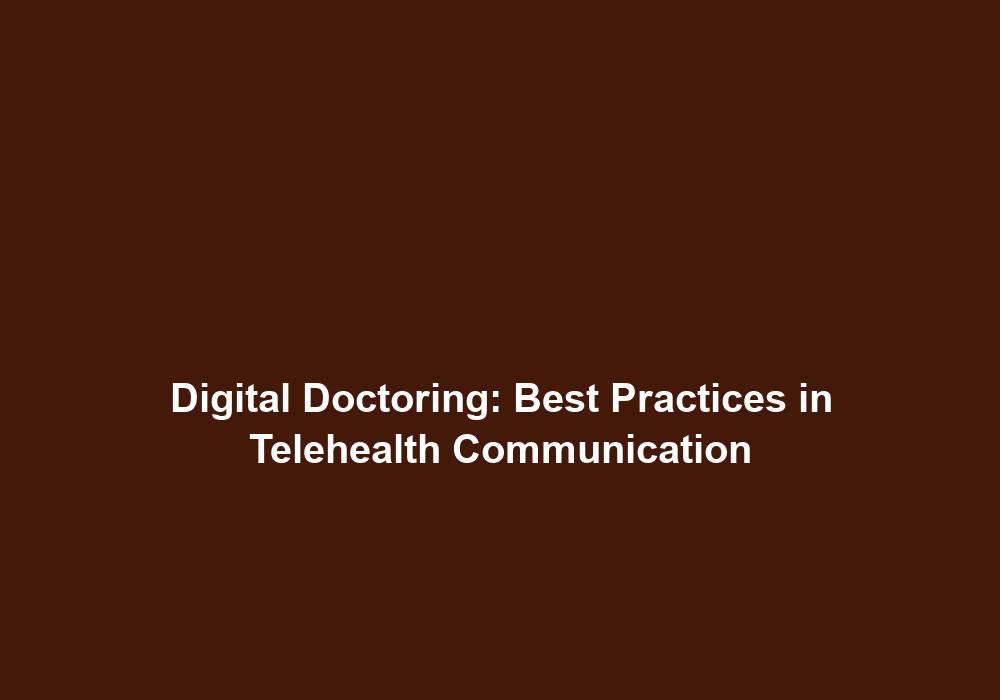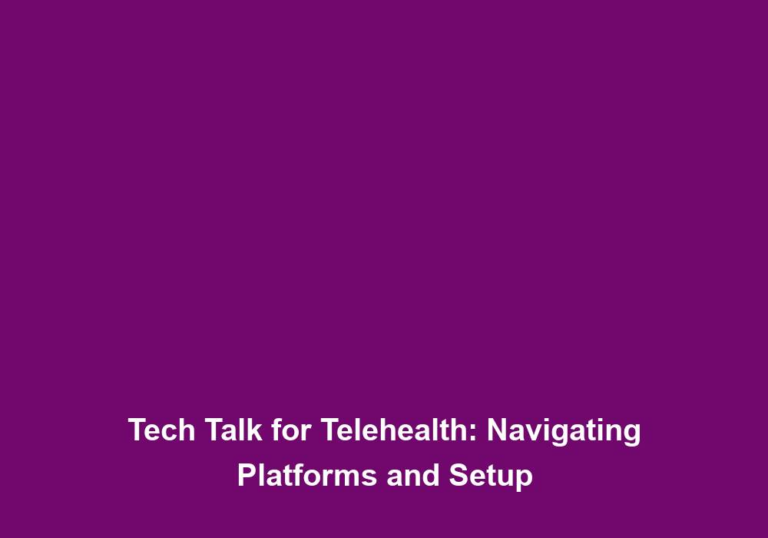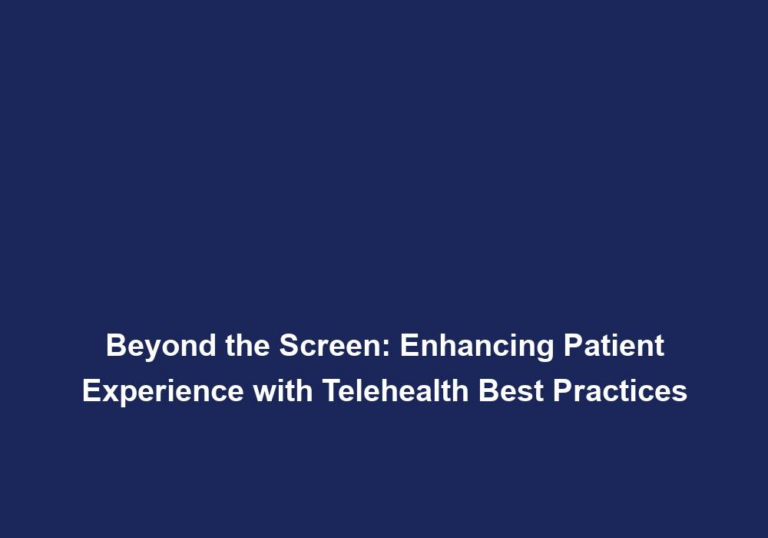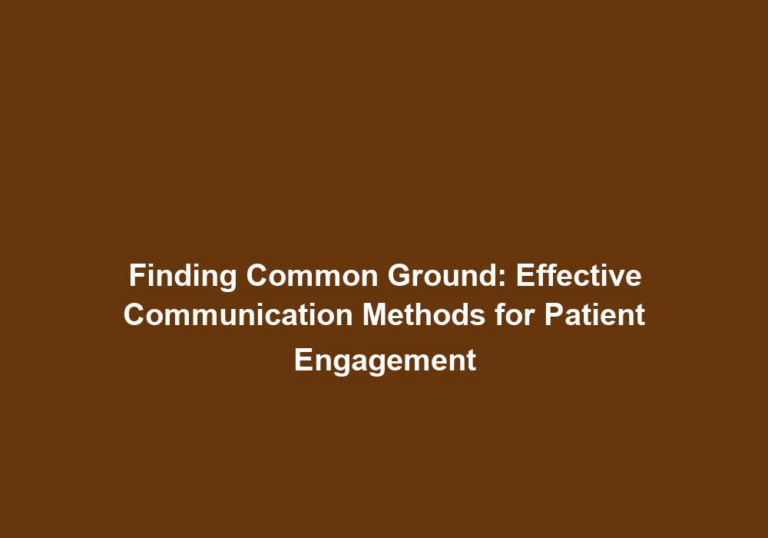Digital Doctoring: Best Practices in Telehealth Communication
In today’s rapidly evolving world, telehealth communication has emerged as a convenient and efficient way to provide medical care remotely. With the advancement of technology and the ever-increasing demand for remote healthcare services, it has become crucial for healthcare providers to adopt best practices in telehealth communication. In this article, we will explore key strategies and tips for effective telehealth communication that can help enhance patient experiences and improve healthcare outcomes.
Importance of Effective Telehealth Communication
Telehealth communication plays a vital role in establishing a strong rapport between healthcare providers and patients. It allows seamless interaction, diagnosis, and treatment, regardless of geographical barriers. Effective communication in telehealth ensures that patients receive the care they need while feeling heard, valued, and understood. It also allows healthcare providers to gather accurate information, make informed decisions, and provide personalized care to patients.
Building Trust and Rapport
Establishing trust and rapport is crucial in any healthcare setting, and telehealth is no exception. Healthcare providers should create a warm and welcoming environment, actively listen to patients’ concerns, and demonstrate empathy and understanding. By establishing trust, patients will feel more comfortable sharing sensitive information, leading to better diagnosis and treatment.
- Greet patients with a friendly and professional tone to create a positive first impression.
- Use open-ended questions to encourage patients to share their thoughts and concerns.
- Validate patients’ emotions and express empathy to make them feel valued and understood.
- Provide clear and honest information to build credibility and trust.
Clear and Concise Communication
In telehealth, where non-verbal cues may be limited, it is essential to communicate clearly and concisely. Using simple language, avoiding medical jargon, and providing clear instructions can help patients understand their condition and follow recommended treatments. Additionally, healthcare providers should encourage patients to ask questions and clarify any doubts they may have.
- Use plain language and avoid medical terminology to ensure patients understand the information provided.
- Break complex explanations into smaller, digestible parts to enhance comprehension.
- Provide written instructions or summaries of the consultation for patients to refer back to.
- Ask patients to repeat or summarize the information discussed to ensure their understanding.
Technology Familiarization
Since telehealth relies heavily on technology, it is crucial for healthcare providers to be well-versed in the platforms and tools used. Familiarity with video conferencing software, electronic health records (EHR) systems, and other telehealth technologies will help ensure a smooth and uninterrupted consultation experience. Providers should also educate patients on how to use these tools effectively.
- Conduct training sessions for healthcare providers to enhance their proficiency in telehealth platforms and tools.
- Provide clear instructions or tutorials to patients on how to access and use the telehealth platform.
- Anticipate technical difficulties and have backup plans in place to minimize disruptions during consultations.
- Regularly update and upgrade telehealth technology to ensure it aligns with the latest standards and best practices.
Adapting Communication Styles
Effective telehealth communication requires healthcare providers to adapt their communication style based on individual patient needs. Some patients may prefer a more direct approach, while others may require additional support and reassurance. Understanding and catering to these preferences can significantly enhance patient satisfaction and engagement.
- Tailor the communication style to match the patient’s personality and preferences.
- Use active listening techniques to understand patients’ concerns and respond appropriately.
- Provide emotional support and encouragement to patients who may be anxious or uncertain.
- Offer additional resources or referrals for patients who may require further assistance or specialized care.
Privacy and Security
Maintaining patient privacy and data security is of utmost importance in telehealth. Healthcare providers should adhere to strict privacy policies and ensure that all communication channels and platforms used are secure and compliant with industry standards. Educating patients about the security measures in place will help build trust and confidence in the telehealth system.
- Implement secure communication channels and encryption protocols to protect patient information.
- Train healthcare providers on privacy regulations and best practices to prevent data breaches.
- Obtain patient consent for the collection and storage of their personal health information.
- Regularly review and update security measures to stay ahead of potential threats and vulnerabilities.
Visual Aids and Information Sharing
Utilizing visual aids, such as diagrams, charts, or images, can be highly effective in telehealth consultations. Sharing relevant information visually can help patients better understand their condition, treatment options, and medication instructions. Additionally, healthcare providers should utilize secure file-sharing platforms to share important documents and resources with patients.
- Use visual aids to simplify complex medical concepts and enhance patient comprehension.
- Share educational videos or interactive materials to engage patients in their own healthcare.
- Utilize screen-sharing capabilities to guide patients through visual information or online resources.
- Ensure that all shared documents and files comply with privacy regulations and security standards.
Follow-Up and Continuity of Care
Telehealth communication should extend beyond the initial consultation. Healthcare providers should establish a system for follow-up appointments, medication management, and ongoing support. Regular check-ins with patients not only ensure continuity of care but also provide an opportunity to address any concerns or issues that may arise.
- Schedule follow-up appointments to monitor patients’ progress and adjust treatment plans if necessary.
- Provide patients with clear instructions on medication schedules and potential side effects.
- Offer remote monitoring solutions to track patients’ vital signs or symptoms remotely.
- Maintain a collaborative relationship with patients’ primary care physicians to ensure coordinated care.
Benefits of Effective Telehealth Communication
Employing best practices in telehealth communication can yield numerous benefits for both healthcare providers and patients. Some key benefits include:
- Improved access to healthcare services, particularly for patients in rural or underserved areas.
- Reduced travel time and costs for patients, resulting in enhanced convenience.
- Enhanced patient engagement and satisfaction through personalized and patient-centered care.
- More efficient healthcare delivery, allowing providers to see more patients and reduce waiting times.
- Better health outcomes through timely and accurate diagnosis, treatment, and follow-up care.
Conclusion
In the digital age, effective telehealth communication is an essential component of modern healthcare. By adopting best practices in telehealth communication, healthcare providers can bridge the gap between physical distance and provide high-quality care to patients remotely. Establishing trust, clear communication, technology familiarity, and maintaining patient privacy are all vital aspects that contribute to successful telehealth consultations. Embracing these best practices will not only improve patient experiences but also revolutionize the healthcare industry as a whole.







